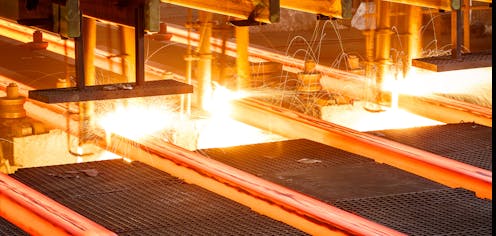China’s green steel push could crush Australia’s dirty iron ore exports
- Written by The Conversation

Australia’s largest export, iron ore, has long been a powerhouse of economic growth. Over the past two decades, its contribution to our national income has surged from just A$8 billion in 2005 to over A$124 billion today.
But the Australian iron ore industry faces a major challenge as its biggest customers – China’s steel mills – move to drastically reduce their carbon footprint.
The issue lies in the purity of our product. Most of Australia’s current iron ore exports are not classed as high grade. Typically, the lower the iron content of an ore is, the more energy is required to refine it.
Our competitors – countries such as Brazil and Guinea with higher-grade ores in relative abundance – are positioned to become the steel industry’s suppliers of choice.
Australia could adapt its production to meet this change in demand. But if it doesn’t do so quickly, it may find itself left behind in the new green economy.
Iron ore’s biggest customer cleans up its act
China is the largest importer of Australian iron by a hefty margin. Australia shipped 736 million tonnes – more than 80% of iron ore exports – to China in 2022.
Last year, China’s steel mills made up the majority of global steel production. But they were also a major polluter, accounting for about 15% of China’s total greenhouse gas emissions.
They’re now facing a double whammy of decarbonisation pressures.
At home, the Chinese government has mandated the steel industry reduce its emissions as part of China’s wider “dual carbon” goals. These will require emissions to peak before 2030 and for the country to become carbon neutral by 2060.
And internationally, upcoming tariffs on carbon-intensive steel imports are set to make producing “dirty” steel much costlier.
Australian ore doesn’t make the grade
Making steel with low-grade iron ore isn’t at all carbon friendly.
For one, it consumes vastly more energy in the traditional steelmaking process. My analysis shows that using one tonne of low-grade ore can emit over 200 kilograms more carbon dioxide in a blast furnace than high-grade.
A high level of impurities in low-grade ore also significantly reduces the efficiency of the process.
Reducing the use of low-grade ore has become a priority for Chinese steel mills, significantly affecting iron ore’s demand profile.
Much of the iron ore exported by competing nations like Brazil and Guinea is high-grade, containing more than 65% iron. But most of Australia’s current exports fall below that threshold, between 56% and 62%.
New technologies
A number of new and emerging steelmaking technologies offer the promise of significantly lower emissions.
But common to all of them is a need for higher-grade iron ore than Australia produces.
There are four new steelmaking technologies in use or under construction by a number of Chinese steel corporations, including the world’s biggest steelmaker – China Baowu Group. These include:
Here’s how these technologies could help China reduce its carbon emissions:
Increased use of steel scraps
Global demand for steel is forecast to increase to 2.2 billion tonnes by 2050.
But that won’t all translate into greater demand for our iron ore.
Overall demand for iron ore could be reduced by the increasing availability and use of steel scraps or “recycled steel”, such as scrapped vehicles, white goods and machinery.
Using one tonne of recycled steel for steelmaking saves 1.4 tonnes of iron ore and avoids about 1.5 tonnes of carbon dioxide emissions.
New tariffs on carbon
A number of legislative measures are on the horizon for the global steel industry, which produced about 7% of global greenhouse gas emissions in 2022.
One such international measure, the European Union’s Cross-Border Adjustment Mechanism (CBAM), has further accelerated a global drive toward sustainable steelmaking.
This legislation acts as a carbon tariff on imports to the EU, initially aimed at carbon-intensive products such as steel. It will be fully in force by 2026.
EU importers of steel products will be required to pay an import carbon tax, at a price set by the EU, based on the differences in carbon emissions between traditional steel mills and the EU’s emission benchmarks.
Being forced to charge higher prices for carbon-intensive steel products will incentivise non-European steel mills to accelerate their transition to green steel.
What lies ahead
The global transition to green steelmaking is bound to shape the future of Australia’s iron ore industry. Reduced demand for Australia’s low-grade iron ore could put pressure on its producers’ revenue, or even force some smaller iron ore miners to shut down.
But it also presents opportunities. Here are two ways Australia could ride the wave:
1. Substantially increase production and export of magnetite.
Australia is abundant in magnetite, an ore type which differs in composition from hematite or “direct shipping ore” (DSO). Magnetite has a low iron content (between 30 and 40%), but can be processed to a higher grade through a process of removing impurities known as “beneficiation”. This process is energy intensive, but could become economically viable if we continue to see rapid uptake of renewable energy.
2. Build direct reduction plants here in Australia.
Unlike the traditional blast furnace process, which uses coal as a source of energy, the direct reduction process uses hydrogen to reduce iron ore into iron without melting it.
There has been much hype around Australia’s potential to produce cheap hydrogen with renewable energy. But if we pull it off, we could stand at the forefront of the green steel revolution as a global production hub of direct reduced iron.
Decisions made by Australia’s major iron ore producers and political leaders will shape the outcome of this global shift. Rather than fear the transition, Australia could take on a leading role.
Read more: 'Green' or 'blue' hydrogen – what difference does it make? Not much for most Australians














